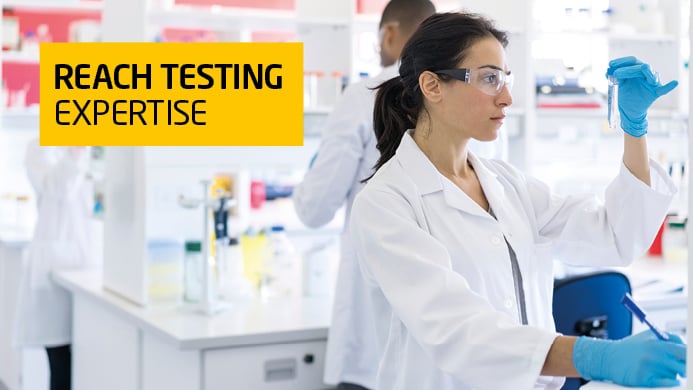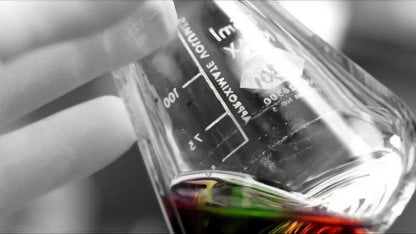REACH testing supporting REACH regulatory compliance in Europe and other regions through experienced analysis including substance ID, sameness and physico-chemical testing programs
REACH testing is central to supporting REACH regulation compliance. The generation, interpretation and evaluation of high-quality data is a key component of REACH substance registration and other regulatory chemical compliance programs (such as CLP regulations) in Europe, UK and across the world.
REACH chemical testing programs will form a critical part of your registration activities. To achieve REACH regulation compliance, companies must identify and manage the risks linked to the substances they manufacture and market in the EU. They have to demonstrate to ECHA the hazards associated with the substance and how it can be safely used, and they must communicate the risk management measures to the users. Manufacturers and importers are responsible for gathering information on the properties of their chemical substances and to do this they need to work together with other companies who are registering the same substance. The "one substance, one registration" principle which is managed through a Substance Information Exchange Forum (SIEF) for each substance. Every registrant has to prove the identity of the substance they are registering in order to confirm they are working together on the same substance. The purpose of the joint registration is so that everyone has access to the best quality hazard and safety information and that there is harmonization across Europe. This enables free circulation of substances on the internal market. Successful registrations enable marketing or market launch of new chemical products.
Chemical identity data, generated to meet regulatory chemical testing programs requirements is a mandatory requirement for ECHA REACH registered substances for both lead and co-registrants. This data should be submitted in the form of a technical dossier using IUCLID software.
As a lead registrant, your dossier includes not only your company specific substance identity information but also information that may be required by all the co-registrants, such as the classification and labelling of the substance and the physical-chemical, toxicological and ecotoxicological data defined in the REACH Annexes. REACH testing programs, data gathering and process can be costly and complex and requires expert assessment of the data and gaps identified. As a member registrant, your dossier includes information about the identity of your own substance such as composition and purity along with the analytical data as evidence to support the composition reported. Members also submit their own specific uses.
Based on our extensive knowledge of global chemical regulatory issues and considerable experience gained during the EU REACH registration deadlines, we continue to offer regulatory chemical testing programs to clients around the world as they look ahead to the UK REACH registration deadlines and the forthcoming revision of the EU legislation REACH Regulation 1907/2006.
We deliver high quality REACH testing data for structural and compositional information (including information on impurities) as part of your substance identity requirements and sameness testing and relevant technical guidance to ease your registration process. With strengths in data assessment we identify any data gaps in the information to complete a dossier and then put in place efficient strategies to address these gaps whilst minimizing unnecessary testing costs.
We adapt our REACH services to your specific needs. We can manage the entire process for you or we can provide you with support for the specific areas where you need assistance. REACH registration dossiers are live documents and are expected to be maintained and updated promptly upon changes or new data.
REACH Substance Identity
REACH substance identification involves characterizing the chemical composition for registration purposes under the REACH Regulation. This entails clearly demonstrating the structure and purity of the substance. This analytical data is evaluated by the authorities upon submission of an Inquiry dossier and if it is deemed inadequate the dossier is rejected and the prospective registrant advised to carry out further analyses to fill in the data gaps. This process can add months to the registration timeline. There is a business compliance risk if a substance is not properly identified, and the wrong substance is registered. Our REACH analysis Laboratories offer diverse analytical techniques and expertise to assist companies in obtaining REACH registration by accurately identifying substances and providing necessary analytical services.
REACH Sameness Testing
REACH sameness testing is essential for co-registrants to confirm if their substances align with the Lead Registrant, requiring detailed chemical information and analytical data. EU REACH introduced Substance Identity Profiles (SIP) where each SIEF published the identity and purity criteria which must be met to confirm substance sameness. Our REACH testing laboratories conduct thorough sameness testing programs for all types of substances including gases, providing robust substance identification, enabling companies to make informed decisions regarding joint registration and compliance with REACH regulations.
REACH Testing for Nanoforms
The EU Regulation 1907/2006 [REACH] amendment 2018/1881, mandates specific obligations for companies involved in manufacturing or importing such nanoforms. Intertek offers comprehensive chemical and physical testing services to help companies comply with these evolving regulatory requirements, including nano-scale analysis covering particle size, shape, dispersion, crystallinity, surface area, surface chemistry / surface modification and composition and Impurities.
Polymers Under REACH
The original EU REACH legislation considered registration of the respective monomers sufficient to cover the compliance of polymers. One of the areas included in the upcoming REACH amendment addresses the requirement to register some polymers. A global evaluation of information on polymers has identified some groups of polymers which may be hazardous and there could be benefits to human health and the environment from properly evaluating their hazards and determining appropriate risk management measures.
Intertek has a wealth of experience in polymer chemistry and can provide analytical strategies and testing for the identification and evaluation of polymeric materials for registration purposes.
Petroleum UVCBs Testing for REACH
Accurate identification of petroleum UVCBs in REACH dossier submission is critical for compliance. Due to the complexity of crude oils, detailed characterisation beyond standard methods is required. Concawe recommends using boiling point and carbon number distribution, plus individual hydrocarbon analysis, for a comprehensive profile. Additional techniques are necessary for complex streams like lubricant base oils and heavy fuel oils. Our scientists use advanced methods to overcome analytical challenges and quantify specific properties such as polycyclic aromatic (PCA) content.
Physico-chemical Testing for REACH
Physico-chemical property testing is crucial for both REACH Registration and chemical substance registration in non-EU countries, providing essential data for Safety Data Sheets and informing toxicological and ecotoxicological test packages. Our testing capabilities encompass a range of physicochemical properties outlined in REACH regulations, including melting temperature, boiling point, and water solubility.
UK REACH Testing
Testing is also critical to UK REACH compliance. Testing such as Substance identity requirements under UK REACH are the same as for EU REACH as described by the UK HSE.
Intertek's REACH experts provide robust support through preparation and technical dossier submission of both Lead and Non-Lead technical dossiers using the IUCLID software and Comply with UK REACH IT system. We are a leading international provider of REACH testing services with a global network of REACH laboratories and a proven track record in providing test data for regulatory submissions and chemical registrations for a wide range of industries.
Testing for REACH Substances of Very High Concern (SVHCs)
Intertek’s SVHC testing and screening services include comprehensive testing of products and preparations for SVHCs over 0.1% w/w. Utilizing our vast wealth of analytical laboratories worldwide, Intertek provides SVHC testing for a broad range of products including petroleum, automotive, aerospace, electronics, consumer, building, cosmetics, and general preparations. Intertek’s global laboratories use modern analytical, quantification, and deformulation techniques on soluble and insoluble materials to create a comprehensive fingerprint of each product for use in the SVHC declaration.
Providing Regulatory Testing for Over 30 Years
Bringing quality and safety to life, Intertek’s experienced REACH test programs are delivered consistently with precision, pace and passion, enabling you, our customer, to power ahead safely. Contact our team now to find out how our high-quality REACH testing data and expert project management can help ease your registration process.
REACH testing involves conducting a series of chemical analysis or laboratory chemical testing to evaluate the safety and compliance of chemical substances with the European Union's REACH regulation. This testing is essential for determining the physicochemical properties, substance identity, and potential hazards of chemicals, aiding in regulatory compliance and risk management.
REACH analysis programs should be highly specific to the substance of interest, include high quality data, accurate data interpretation or robust scientific justification where challenges in testing or interpretation has driven the choice of a non-standard analytical technique or approach. Typically, experienced analytical scientists are required to design these highly relevant REACH analytical strategies.
Our scientists use QSAR software for predicting substance properties based on data from similar chemicals which can help to group chemicals into categories and to fill data gaps by read-across, trend analysis or (Q)SAR to assess the (eco)toxicity hazards of chemicals.


